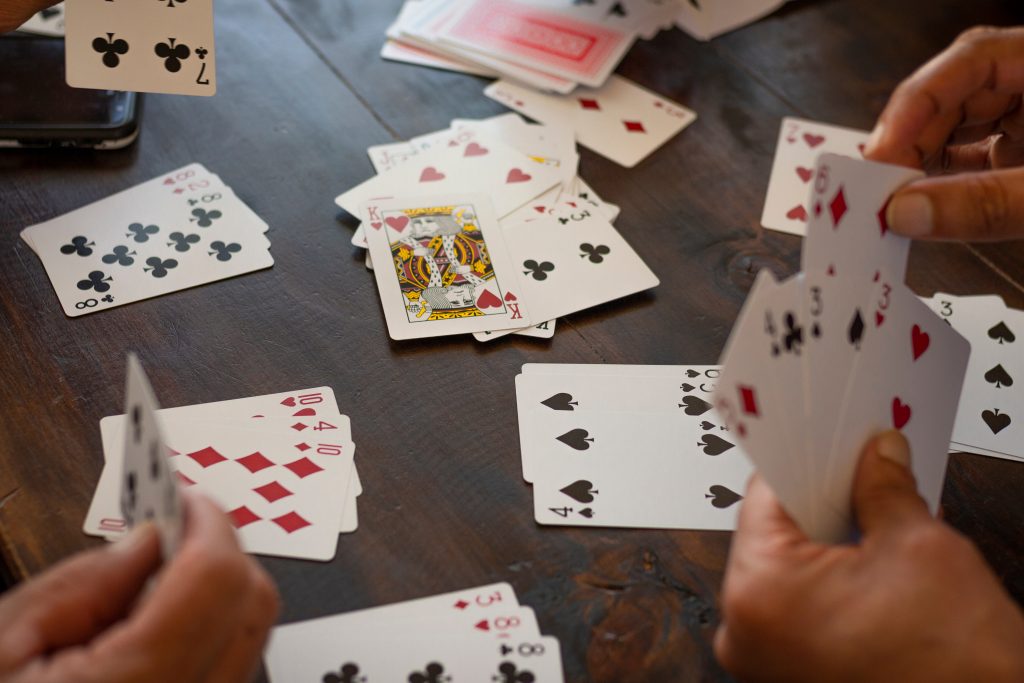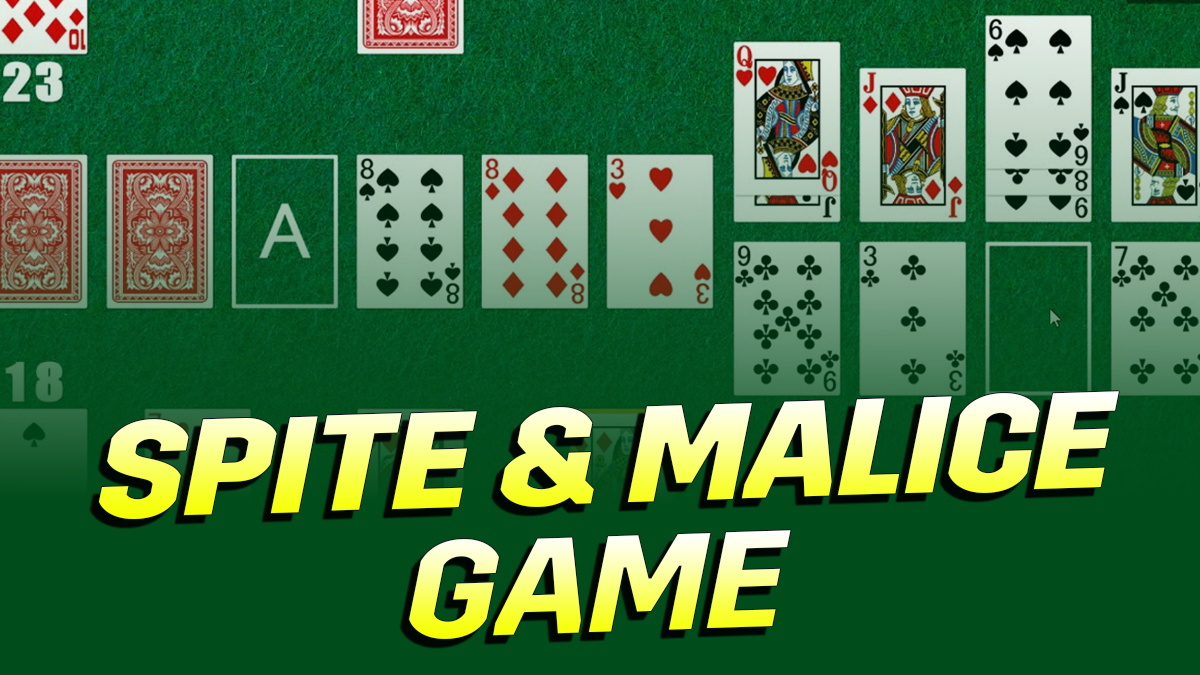Table of Contents
ToggleSpite and Malice is a competitive card game rooted in classic solitaire mechanics. Played with two or more players, the goal is to be the first to clear your goal pile by playing cards in ascending order onto shared play piles. Players can use strategy and blocking tactics to hinder opponents while advancing their own progress.
The game requires multiple decks. Beginners must focus on the Spite and Malice rules, turn structure, and optimal card placement for winning. Like every card game, practice is central to learning strategic play. So, here’s a guide to learning how to play spite and malice including the basic rules and strategy to win.
Spite and Malice Rules
- Players do not look at their goal pile but flip the top card face up. The remaining cards go into a central draw pile.
- Blocking moves are allowed if a player cannot use their goal pile card but wants to prevent others from playing.
- Players end their turn by placing a card in a discard pile.
- Cards must be played from the discard pile in reverse order (last in, first out).
- Players cannot touch opponents’ discard piles.
- Suits do not matter in the Malice and Spite card game.
- Also, aces cannot be discarded.
Discover everything you need to know about the Horse Race Card Game!
How to Play Spite And Malice
Learning how to play Spite and Malice card game involves dealing cards, card play dynamics, types of moves, strategies, and how to win.
Objective
The objective in the Spite and Malice game is to clear all the cards from your play stack by playing them onto the center building piles. These building piles follow a strict ascending order, starting from Ace and progressing to Queen (A-2-3-4-5-6-7-8-9-10-J-Q). Kings are wild and can substitute for any card. The first player to empty their stockpile wins.
Requirements
- Number of Players: 2+ (Best with 2-4 players)
- Two or more regular playing card decks (52-cards.) Jokers are optional. Three decks are used when there are three players.
- A flat playing surface (table or floor)
- Score sheet and pen/pencil (optional, if keeping score)
Setup and The Deal
Each player is dealt 20 cards, forming their stockpile (pay-off pile), which remains face-down. The top card of each pay-off pile is turned face-up. The rest of the cards form the draw pile, placed in the middle.
Players also have four personal discard piles to store unwanted cards strategically. The game is played in a turn-based format, moving clockwise.
Playing the Cards

Source: Alexander Canas Arango /shutterstock
1. Drawing Cards
- At the start of a turn, players draw cards from the common draw pile until they have five cards in hand.
- If a player has fewer than five cards at the beginning of their turn, they draw additional cards to complete their hand.
2. Playing Cards
Players can play cards in three ways:
- Building Piles (Center Piles) – Cards from hand, payoff piles, or discard piles can be played onto the center piles if they follow the sequence (A to Q). Kings are not used in building center stacks.
- Personal Discard Piles – Players can discard one card from their hand to one of their four discard piles, ending their turn. Only the top card of each discard pile is available for play on future turns.
- Using Wild Cards – Kings are wild and can substitute for any card in the sequence.
3. Continuing a Turn
- If a player successfully plays all five cards from their hand onto the center piles, they immediately draw five new cards and continue their turn.
- If no further moves are possible, they end their turn by discarding one card.
4. Ending a Turn
A turn in the Spite and Malice game ends when a player discards a card from their hand into one of their personal discard piles. Only the top card of each discard pile is playable.
5. Opponent’s Turn
- The next player follows the same steps: drawing, playing, and discarding.
- If their stockpile’s top card is higher than the opponent’s, they play first.
Blocking
An important aspect of Spite and Malice is preventing your opponent from advancing. It can be done in several ways:
- Holding onto key cards: If your opponent’s next goal card is a 7, keeping cards like 4-5-6 in hand can prevent them from playing up to their goal card.
- Controlling the playing piles: Avoid playing cards that would allow your opponent to play their stockpile cards.
- Discarding: Place high-value cards in the discard piles while keeping low cards accessible.
If an opponent is close to finishing their stockpile, it may be best to keep playable cards in hand until a sequence can be played that prevents their move.
Winning
A player wins the game by successfully playing all the cards from their stockpile onto the center playing piles. If the draw pile runs out of cards before a player finishes their stockpile, the game ends in a draw.
In some variations, if a player finishes their stockpile and there are still cards left in the draw pile, scoring takes place. The winner earns five points for clearing their stockpile, plus an additional point for each remaining card in their opponent’s stockpile.
Games can be played to a pre-determined score, such as 25, 50, or 100 points.
Spite and Malice Game Strategy
- Prioritize Your Goal Pile: Always aim to play the top card of your goal pile first. Other moves are secondary. Avoid unnecessary plays that don’t advance your goal pile.
- Monitor Your Opponent’s Goal Pile: Be mindful of moves that might help your opponent progress. Only play cards that benefit both players if they also serve your strategy.
- Utilize Your Hand Effectively: Keep sequential cards that lead up to your goal card. If your goal card is a 10, holding 7-8-9 improves your chances of playing it quickly.
- Optimize Hand Clearance: Playing all five hand cards for a full refresh is useful but should not give your opponent an advantage.
- Use Kings Strategically: Kings are wild in Spite and Malice rules. They can bridge gaps in your sequence and block your opponent’s progress. Use them wisely.
- Discard Pile Management: Stack high cards together to avoid burying lower-value cards. If needed, place low cards over high ones rather than the reverse. The best thing is to make piles with cards of the same rank. Fill all discard slots before stacking cards, keeping some for high-value discards only.
- Blocking Your Opponent: Choose not to play a card if it prevents your opponent from progressing. Holding back key cards can slow them down.
- Goal Pile First Rule: When the same card is available in your hand and goal pile, play from the goal pile first—it’s the only pile that truly matters.
- Anticipate Opponent’s Moves: If your opponent has a few goal pile cards left, save your plays for a longer sequence to disrupt their strategy.
Spite and Malice Online
Spite and Malice online lets you play the classic competitive card game against a computer opponent in a two-player version. The goal is to empty your stockpile before your opponent by playing cards in sequence. Many online versions offer multiplayer, customizable rules, and cross-platform play. Some include chat features, leaderboards, and difficulty levels for an engaging and strategic experience.
Major Variations of Spite and Malice
| Variation | Main Difference |
| Number of Centre Stacks | Some versions allow unlimited center stacks, while others limit them to a maximum of four. |
| Compulsory Play of Aces | Aces must be played immediately when drawn; they cannot be retained in hand. |
| Playing with Jokers | Jokers are wild and can represent any card. Some versions allow Kings as wild, while others require 13 cards to complete a center stack ending with a King. |
| Scoring | The winner scores 5 points plus 1 per remaining opponent’s pay-off card. In a stalemate, the player with fewer pay-off cards scores the difference. The target score (e.g., 50) determines the overall winner. |
| Book Version | Uses two distinct decks with specific rules for side-stack discards, forced play of Aces/Twos, and restrictions on Jokers. Some books allow unlimited center stacks, while others limit them to four. |
A Brief History of Spite and Malice
Spite and Malice is a competitive solitaire card game. It is based on the 19th-century games Crapette and Russian Bank. The game originated in Europe and became popular in the United States after World War I. A variation called Flinch was released in 1905. The commercial version of Skip-Bo was introduced in 1967.
Spite and Malice card game was not widely recorded until the 1960s. The Santa Fe Magazine mentioned it in 1963. Richard L. Frey documented the first rules in 1965. John McLeod later noted that book versions of the game differ from traditional rules played by most people.
Conclusion
Mastering Spite and Malice rules takes patience. Observing opponents’ tendencies and predicting their moves can provide an advantage. Some players favor aggressive blocking, while others focus on rapid goal pile clearance.
Adjust your strategy based on their approach to increase your chances of winning. Experiment with different play styles and adapt to your opponents. Over time, experience and pattern recognition will sharpen your skills.
Curious about Pai Gow Poker? Learn here.
FAQs
What is the card game that is similar to Spite and Malice?
The card game similar to Spite and Malice is Misery. It is played with two players using two decks, two goal piles of 12 per player, and a hand of six cards.
What is the other name for Spite and Malice card game?
The other name for Spite and Malice is Cat & Mouse. It is a competitive card game for two or more players. Traditionally, it is played with standard decks, focusing on sequencing and strategic play.
Can four people play the Spite and Malice game?
Yes, four people can play Spite and Malice. It is a competitive multiplayer version of Solitaire for 2 to 4 players. Players take turns discarding goal cards onto play piles, which start with an ace and end with a queen.
Can we use Kings to build center stacks in Spite and Malice?
No, Kings cannot be used to build center stacks in Spite and Malice. Play piles start with an Ace and are built sequentially to a Queen, excluding Kings.
Do suits matter in Spite and Malice?
Suits do not matter in Spite and Malice, except possibly during a specific determining value moment. The game focuses on numerical sequencing, with play piles built from Ace to Queen regardless of suit.








